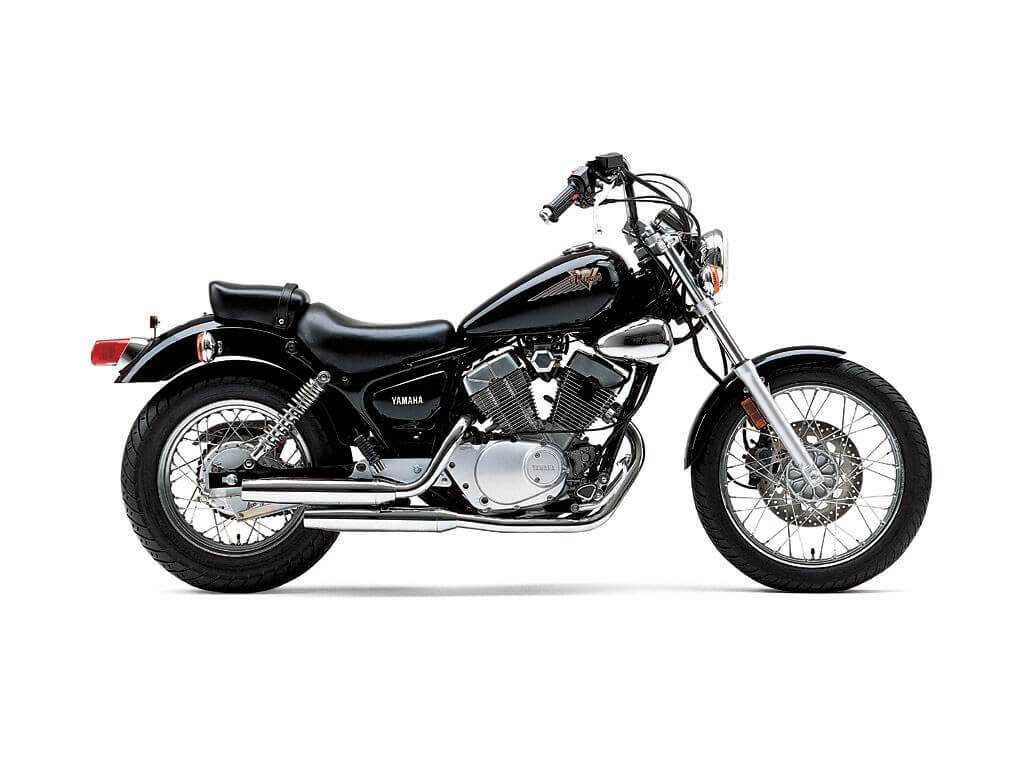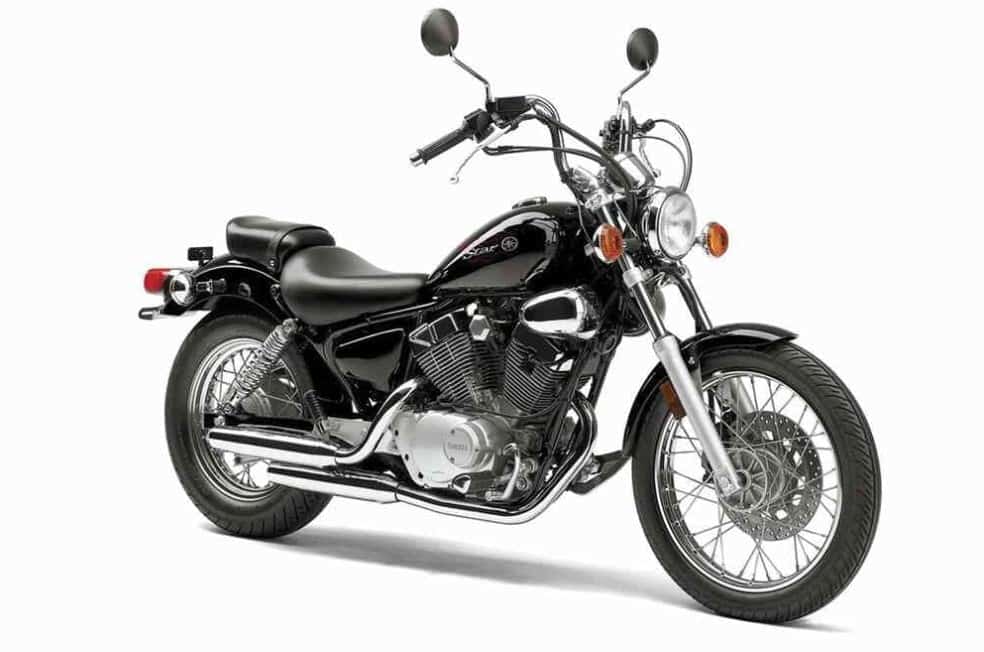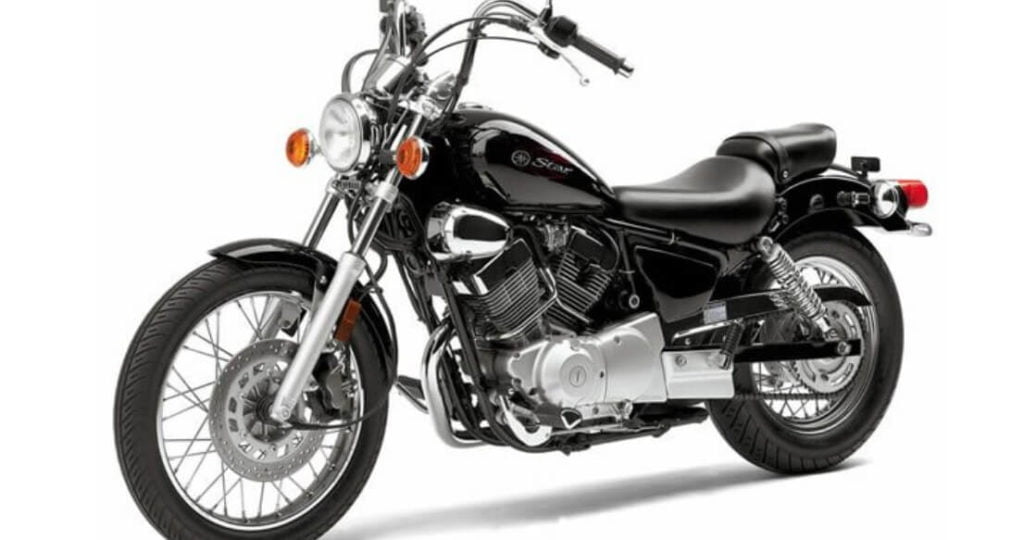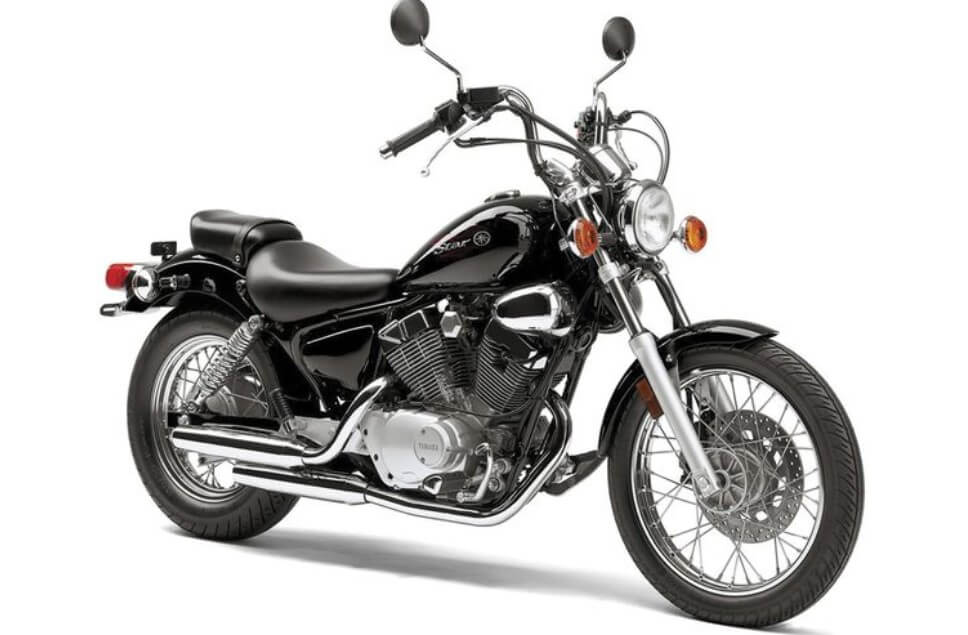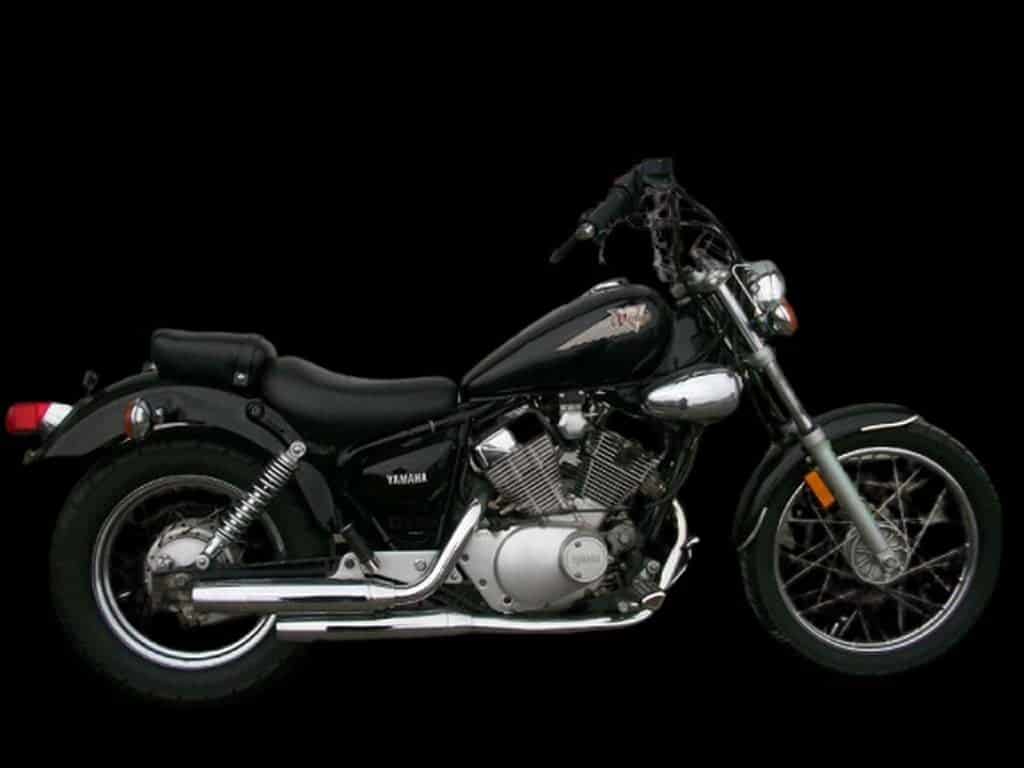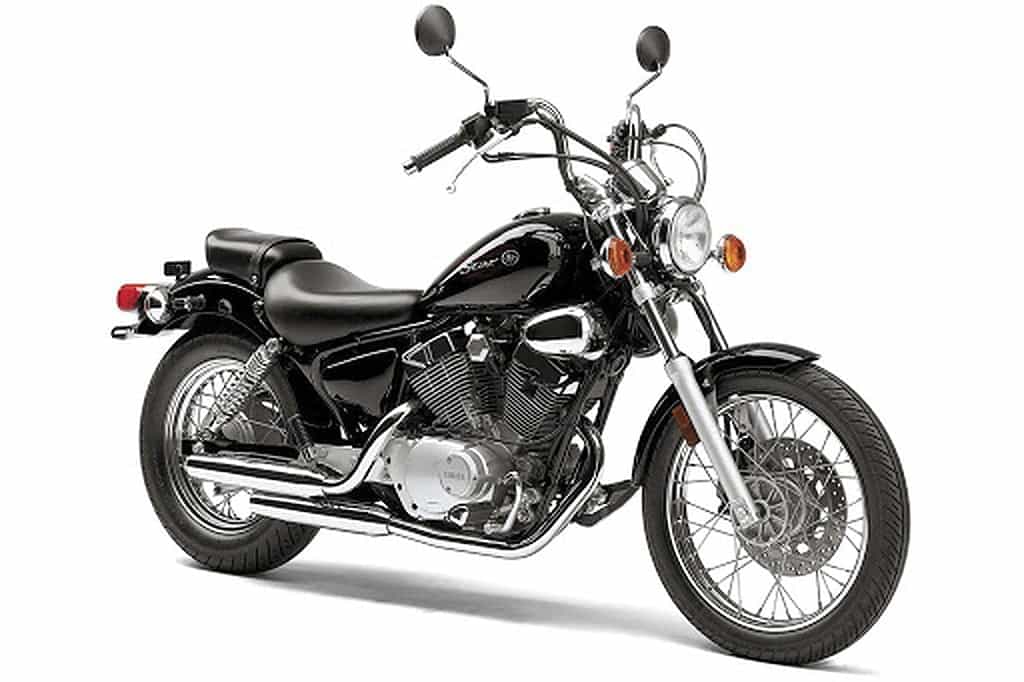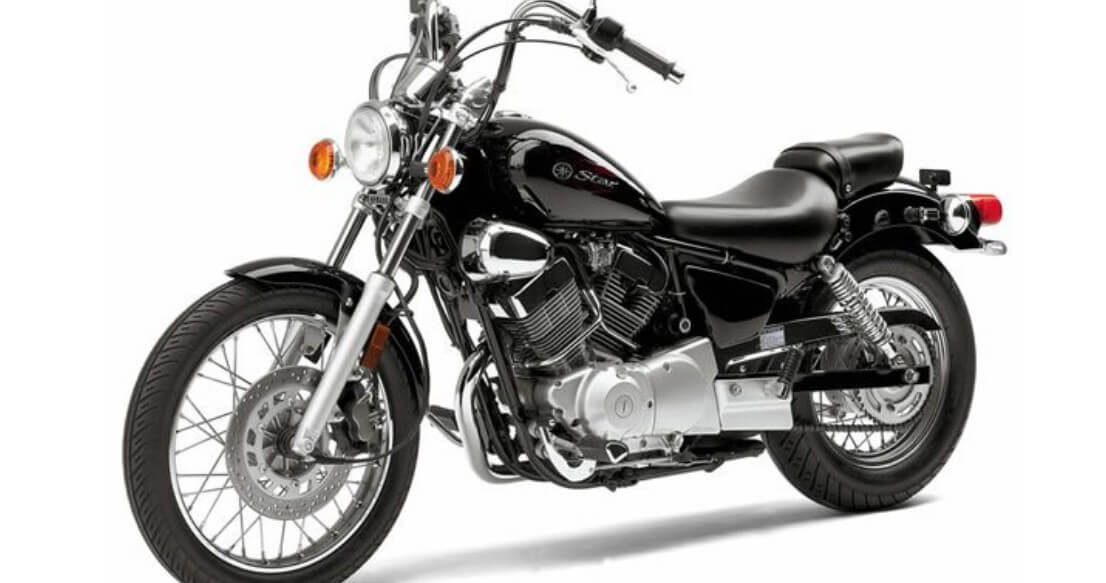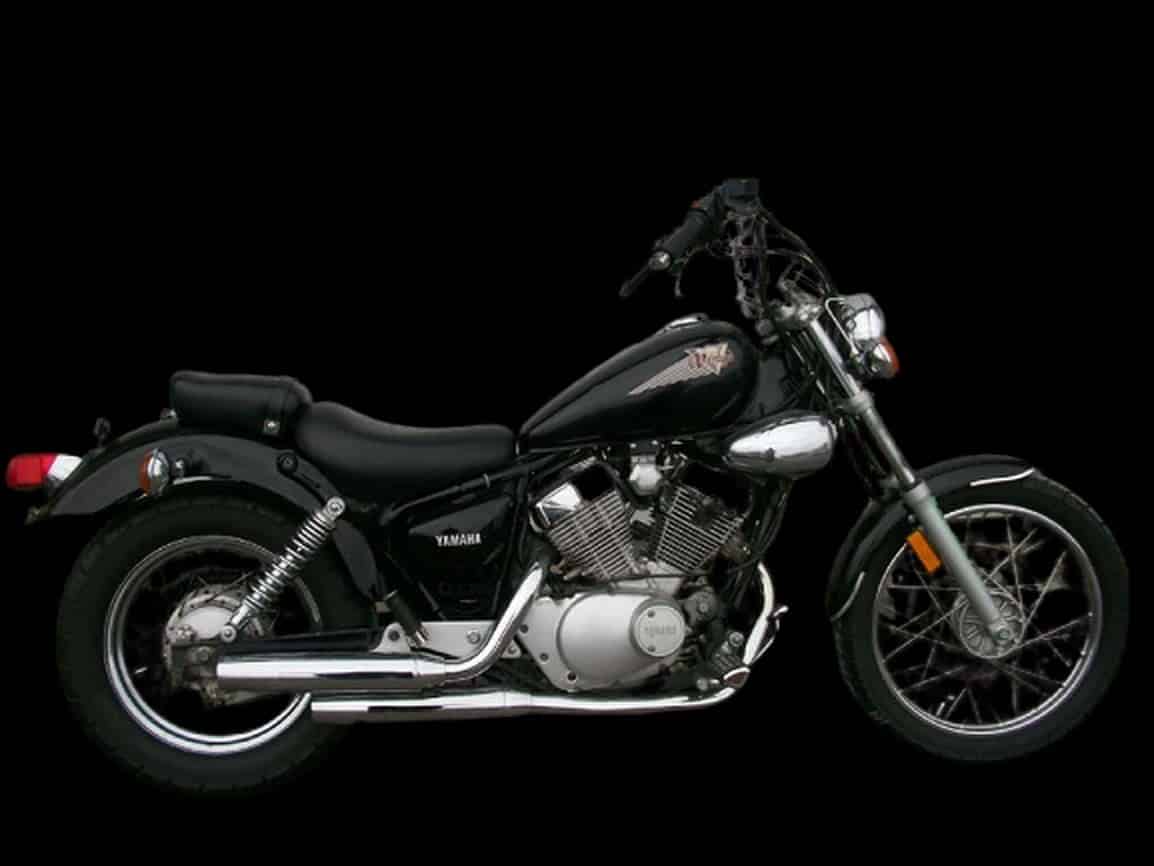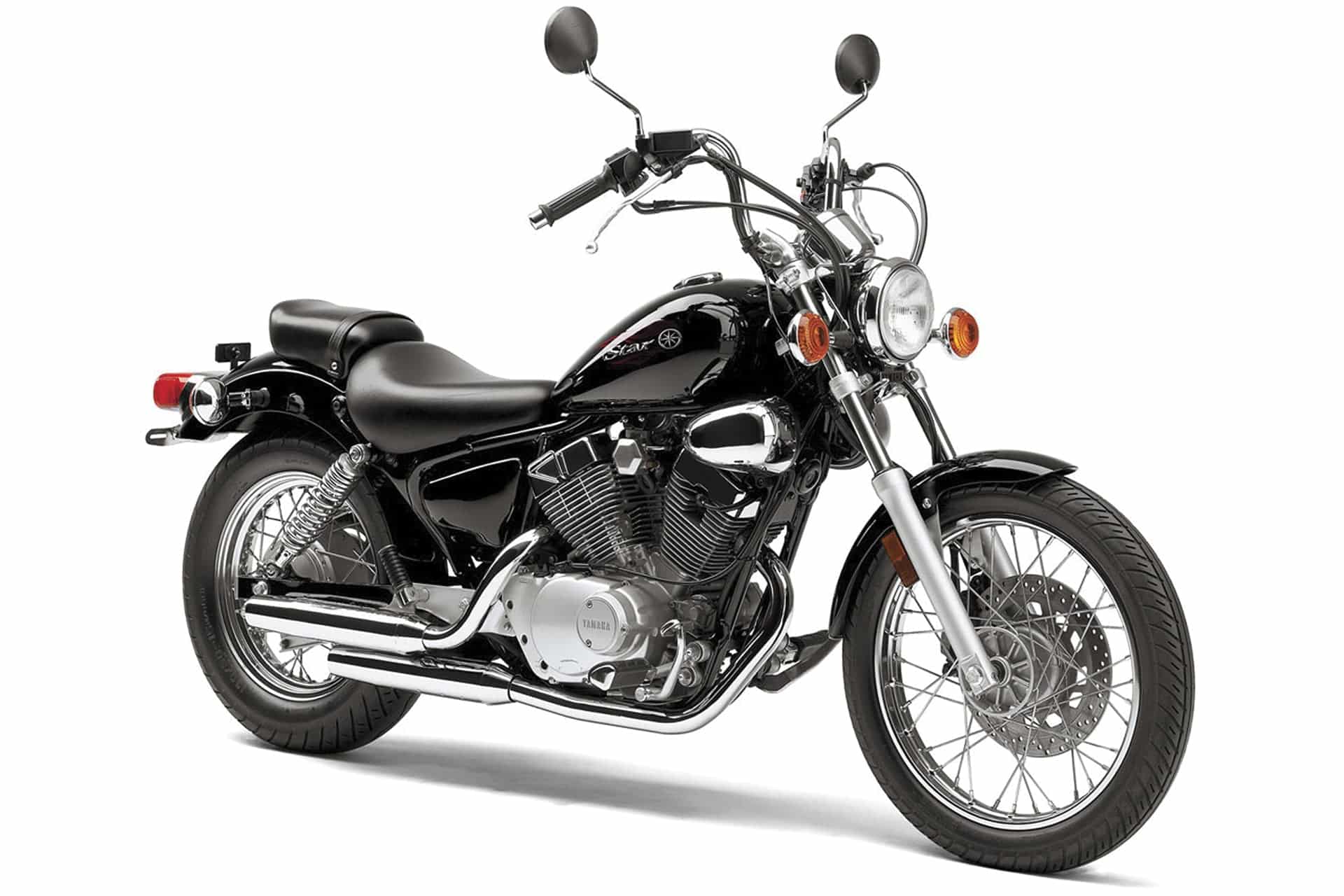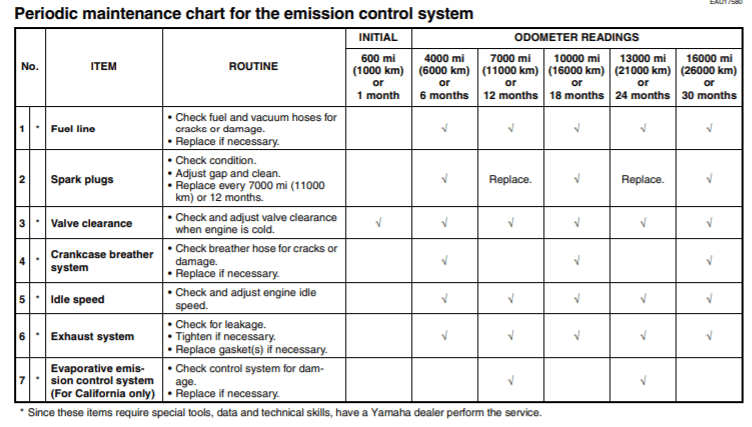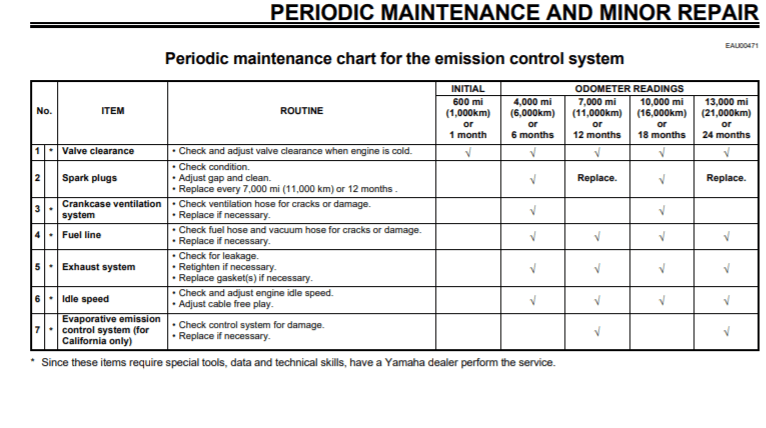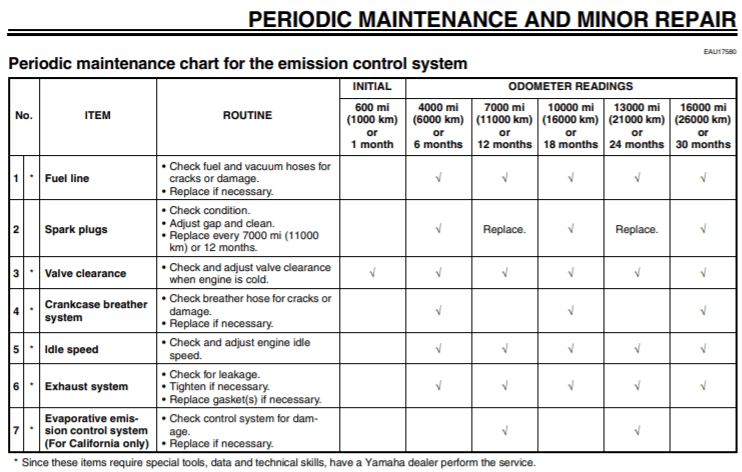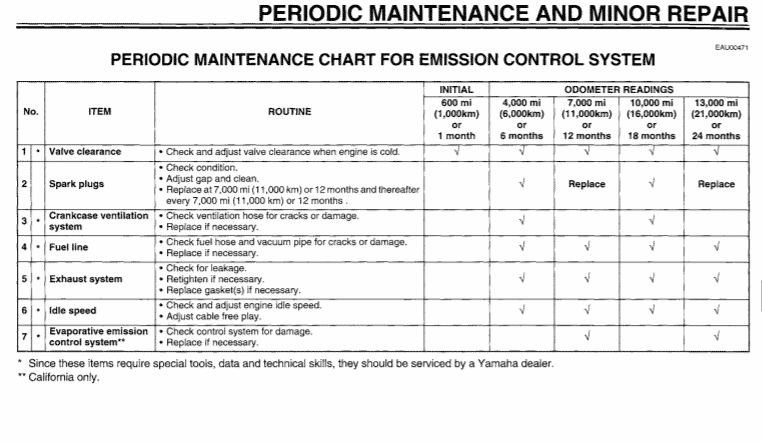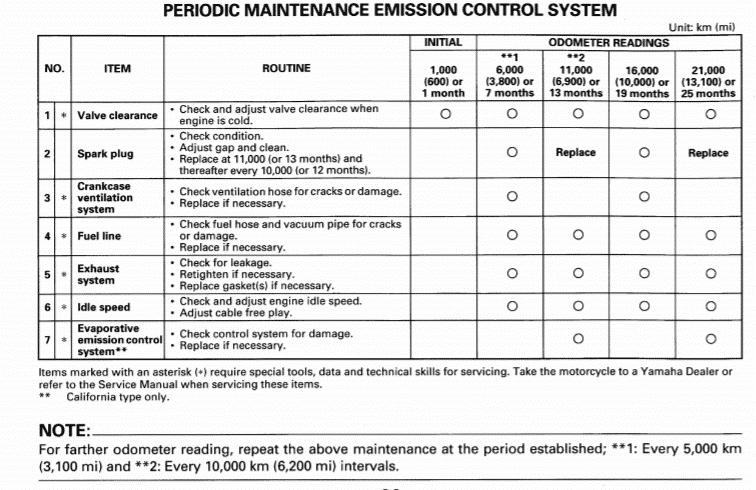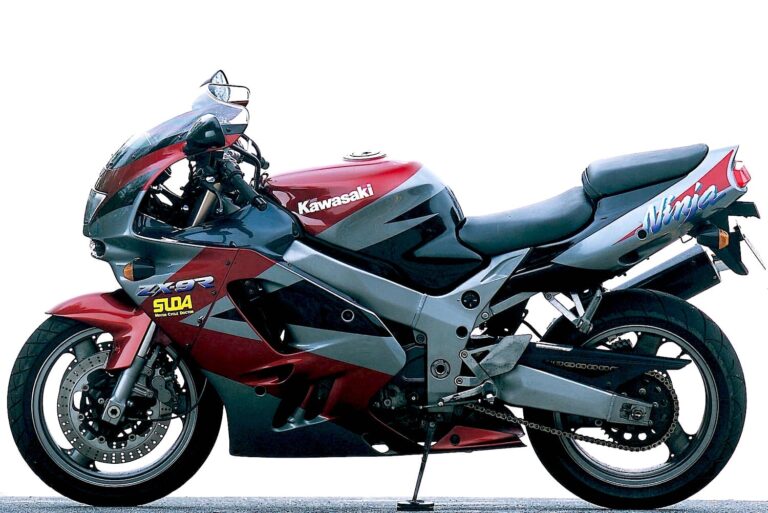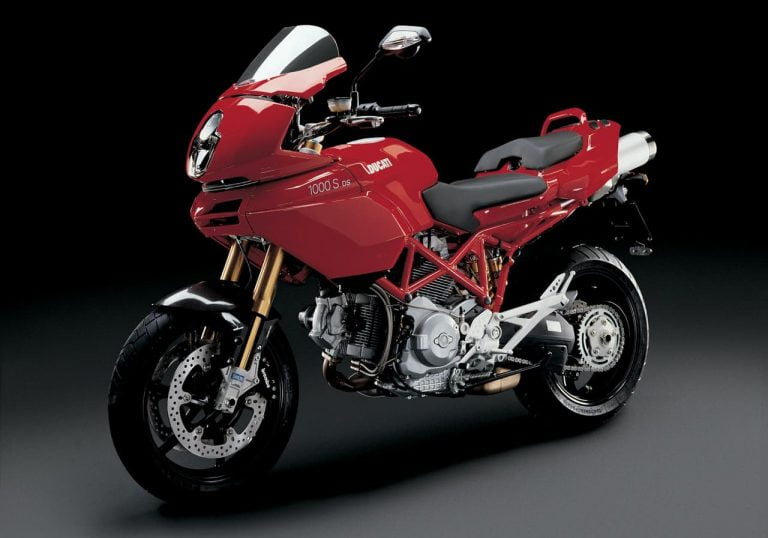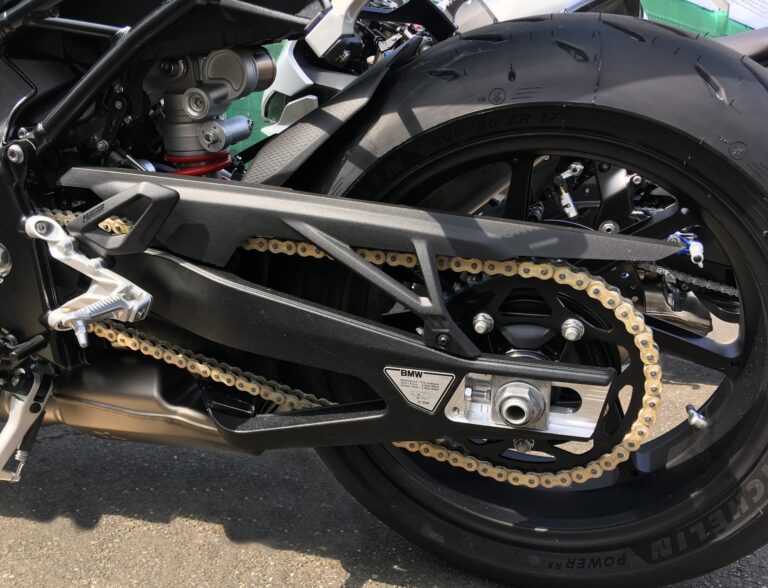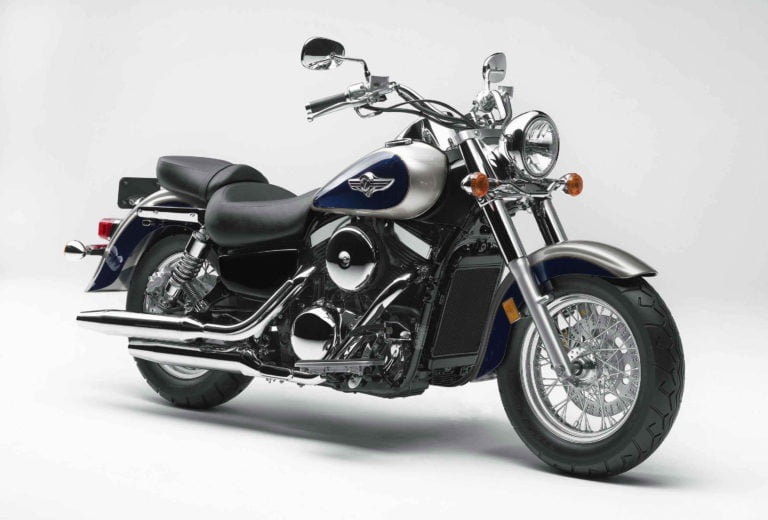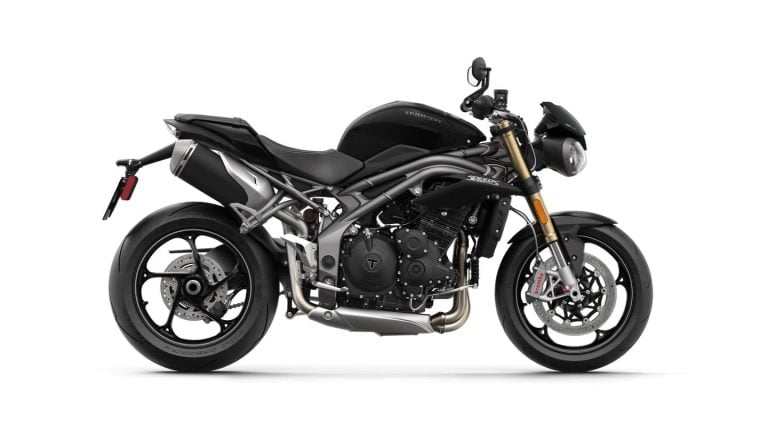Yamaha Virago 250 (XV250) Maintenance Schedule and Service Intervals
This is the maintenance schedule and associated service intervals for the Yamaha Virago 250 for all years up until 2007.
The Virago 250 is powered by a 249cc air-cooled V-twin. It has a single overhead cam and two valves per cylinder, and is fed by a Mikuni carburettor. The engine makes max power of 23 hp (17 kW) at 8000 rpm, or 22 Nm (16 ft-lb) at 6000 rpm. Final drive is via a 5-speed transmission and a chain.
Here are our other Virago maintenance schedules:
- Yamaha Virago 250 (XV250)
- Yamaha Virago 535 (XV535)
- Yamaha Virago 750 (XV750) — WIP
- Yamaha Virago 1100 (XV1100)
After 2007, the Virago 250 was replaced by the Yamaha V Star 250 — although that was 99% a re-brand!
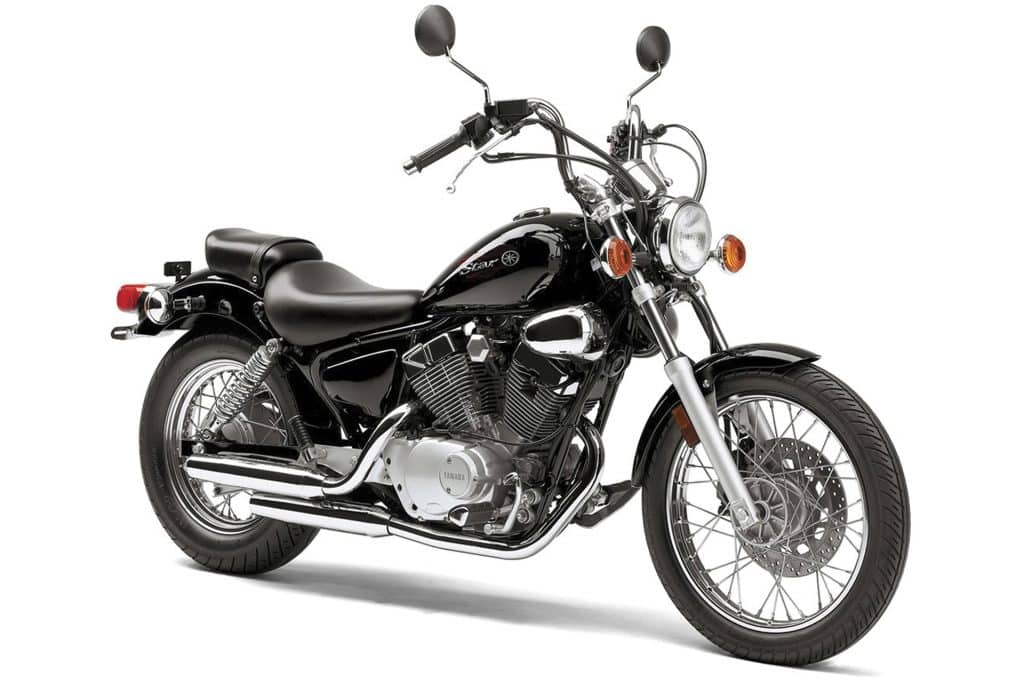
This site has links for things like oil and spark plugs from which we earn a commission (which unfortunately nobody can save, not even us). If you appreciate this work, then please use those links. Thanks!
Yamaha Virago 250 Service Intervals
The service intervals for the Yamaha Virago 250 are every 4000 miles or 7000 km, or every 6 months.
At every service, Yamaha requires you to change the engine oil and to check or replace the spark plugs.
Yamaha also wants you to check and adjust the valve clearances at every service on the Virago 250. However, there are only two cylinders, and only two valves in each one.
Otherwise, keep the brake fluid fresh and maintain the drive chain, and you’re golden.
What you need to service the Yamaha Virago 250
Firstly, you need some basic motorcycle maintenance tools. But aside from that, you also need
| Product | Description |
|---|---|
| Oil | The manual suggests Yamalube 10W-40 or Yamalube 10W-50 (if you ride in heat over 100F/40C). You need 1.4L without changing the oil filter, or 1.6L with changing it, so one gallon/4L should be good for two changes. Tighten the oil drain bolt to 34 Nm (25 ft-lb). |
| Oil filter | Replace the oil filter every time you change the oil. Standard Yamaha part is 5JX-13440-00-00, or you can use a HF145. Tighten to 10Nm (7.2 ft-lb). The benefit of the K&N is you don’t need a special tool to remove it (you can use a regular wrench). |
| Spark plugs | Use NGK spark plugs with code C6HSA (sold individually). Make sure they’re gapped to 0.6-0.7mm with an appropriate spark plug gapping tool, and tightened to 13 Nm (9.4 lb-ft) with an appropriate torque wrench. |
| Air filter | Standard Yamaha part number is 2UJ-14451-00-00. You can also use the K&N part YA-2588 which is more available. |
| Chain lube | Motul chain paste is a highly-regarded chain lubricant to use on the chain (the V Star 250 doesn’t have a belt, unlike nearly all its bigger siblings). You might also need a chain cleaner brush. |
| Brake pads | The front brake pads have parts code 4HM-W0045-00-00, and the rear brake shoes have parts code 19D-W253E-00-00. |
| Brake Fluid | You can use any DOT 4 brake fluid (the one we recommend is a high-grade synthetic one) |
Yamaha Virago 250 Maintenance Schedule
Below is the maintenance schedule for the Yamaha Virago 250.
Notes:
- At the end of the stated maintenance schedule, keep following it in the pattern shown.
- Where there’s a time and a distance-based interval (i.e. most items), follow the earlier of the two.
Generally speaking, the service intervals for the Virago 250 are:
- Change the oil every 4000 miles / 6000 km. At every service check the valve clearances, clean the air filter, and check the spark plugs.
- Every second service, change the spark plugs
- Change brake fluid every 2 years.
| mi x 1000 | 4 | 8 | 12 | 16 | 20 | |
|---|---|---|---|---|---|---|
| km x 1000 | 7 | 13 | 19 | 25 | 31 | |
| Months | 6 | 12 | 18 | 24 | 30 | Every |
| Change engine oil (warm engine before draining) with Yamalube 10W-40 | ✓ | ✓ | ✓ | ✓ | ✓ | |
| Replace engine oil filter (HF145) | ✓ | ✓ | ||||
| Check spark plugs. Adjust gap and clean. Replace (R) periodically (C6HSA) | ✓ | R | ✓ | R | ✓ | |
| Check and adjust valve clearance when engine is cold. | ✓ | ✓ | ✓ | ✓ | ✓ | |
| Check and adjust engine idle speed. | ✓ | ✓ | ✓ | ✓ | ✓ | |
| Clean air filter with solvent. Replace if necessary (YA-2588) | ✓ | ✓ | ✓ | ✓ | ✓ | Clean / replace more often if riding in dust/wet. |
| Check fuel and vacuum hoses for cracks or damage. Replace if necessary. | ✓ | ✓ | ||||
| Check battery specific gravity and breather hose for proper operation. | ✓ | ✓ | ✓ | ✓ | ✓ | |
| Check clutch operation. Adjust or replace cable. | ✓ | ✓ | ✓ | ✓ | ✓ | |
| Check front brake operation, fluid level, and for fluid leakage. Adjust brake lever free play and replace brake pads if necessary. | ✓ | ✓ | ✓ | ✓ | ✓ | |
| Check rear brake operation. Adjust brake pedal free play and replace brake shoes if necessary. | ✓ | ✓ | ✓ | ✓ | ✓ | |
| Check brake hoses for cracks or damage. | ✓ | ✓ | ✓ | ✓ | ✓ | |
| Replace brake hoses | 4 years | |||||
| Replace brake fluid (Castrol DOT 4) | 2 years | |||||
| Check wheel runout, spoke tightness and for damage. Tighten spokes if necessary. | ✓ | ✓ | ✓ | ✓ | ✓ | |
| Check tire tread depth and for damage. Replace if necessary. Check air pressure. Correct if necessary. | ✓ | ✓ | ✓ | ✓ | ✓ | |
| Check wheel bearings for smooth operation. Replace if necessary. | ✓ | ✓ | ✓ | ✓ | ✓ | |
| Check swingarm bush assemblies for looseness. Lubricate with lithium soap-based grease. | ✓ | ✓ | ✓ | ✓ | ✓ | |
| Check drive chain slack, alignment and condition. Adjust and thoroughly lubricate chain (Protect all cable life) | 300 mi (500 km), or after chain gets wet/dirty | |||||
| Check steering bearing assemblies for looseness. Moderately repack (R) with lithium soap-based grease | ✓ | ✓ | R | ✓ | ✓ | |
| Check all chassis fitting and fasteners. Correct if necessary (tighten/replace) | ✓ | ✓ | ✓ | ✓ | ✓ | |
| Brake lever — Apply silicone grease lightly. | ✓ | ✓ | ✓ | ✓ | ✓ | |
| Brake pedal — Apply lithium-soap-based grease lightly. | ✓ | ✓ | ✓ | ✓ | ✓ | |
| Clutch lever — Apply lithium-soap-based grease lightly. | ✓ | ✓ | ✓ | ✓ | ✓ | |
| Shift pedal — Apply lithium-soap-based grease lightly. | ✓ | ✓ | ✓ | ✓ | ✓ | |
| Sidestand pivot — Check operation. Apply lithium-soap-based grease lightly. | ✓ | ✓ | ✓ | ✓ | ✓ | |
| Sidestand switch — Check operation and replace if necessary. | ✓ | ✓ | ✓ | ✓ | ✓ | |
| Check front fork operation and for oil leakage. Replace or repair if necessary. | ✓ | ✓ | ✓ | ✓ | ✓ | |
| Check rear shock operation and for oil leakage. Replace or repair if necessary. | ✓ | ✓ | ✓ | ✓ | ✓ | |
| Check front and rear brake switch operation. | ✓ | ✓ | ✓ | ✓ | ✓ | |
| Apply cable lubricant thoroughly (Protect All Cable Life) to control and meter cables | ✓ | ✓ | ✓ | ✓ | ✓ | |
| Check throttle operation. Check throttle grip free play and adjust if necessary. Lubricate the throttle grip housing and cable. | ✓ | ✓ | ✓ | ✓ | ✓ | |
| Check operation of lights, signals, and switches. Adjust headlight beam. | ✓ | ✓ | ✓ | ✓ | ✓ | |
| Check crankcase breather hose for cracks or damage. Replace if necessary. | ✓ | ✓ | ✓ | |||
| Check exhaust for leakage. Tighten if necessary. Replace gasket(s) if necessary. | ✓ | ✓ | ✓ | ✓ | ✓ | |
| Check evap control system for damage. Replace if necessary. | ✓ | ✓ |
About the Yamaha Virago 250
The Yamaha Virago 250 is an entry-level cruiser motorbike from Yamaha with a purring little 249 cc V-twin engine.
The 60-degree V-twin is fed by a Mikuni downdraft carburettor that gives good fuel/air mixing and throttle response.
It’s not a terribly powerful motorcycle, but it’s easy to use. When pushed, you can get it to about 75 mph (120 km/h) when on a straight and without a headwind. But it’s not a motorcycle that’s really built for (or is capable of) long-distance touring.
The widely geared five-speed transmission makes the most of Virago 250’s gentle powerband.
The Virago 250 is a very simple motorcycle, to the point where the marketing material calls out things like a front disc brake, quietly ignoring that the rear brake is a drum.
But the Virago 250 is an easy-to-ride motorcycle that looks really good. For people who want something to beat around the city and not ride at particularly high speeds, it’s an excellent choice.
Basically, the Yamaha Virago 250 is an easy, small motorcycle that starts every time and which will go forever, or until you decide you want an upgrade.
Manual for the Yamaha Virago 250
The above information was gleaned from the owner’s manual for various years of the Yamaha Virago 250, with edits made from earlier manuals, and also consulting parts fiches.
Below are screenshots from manuals of many years of the Virago 250.
You can download it from Yamaha’s website here.
